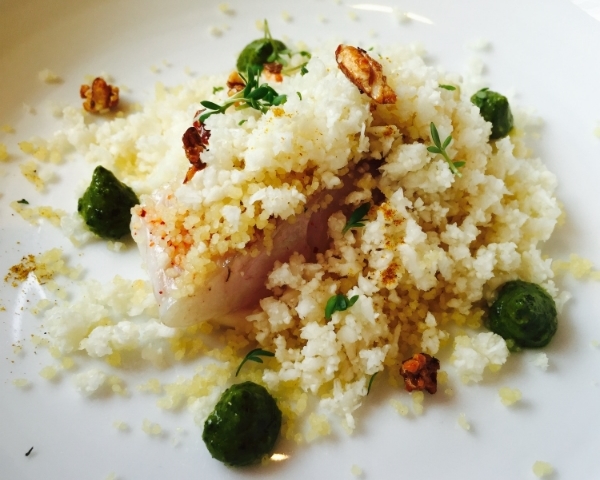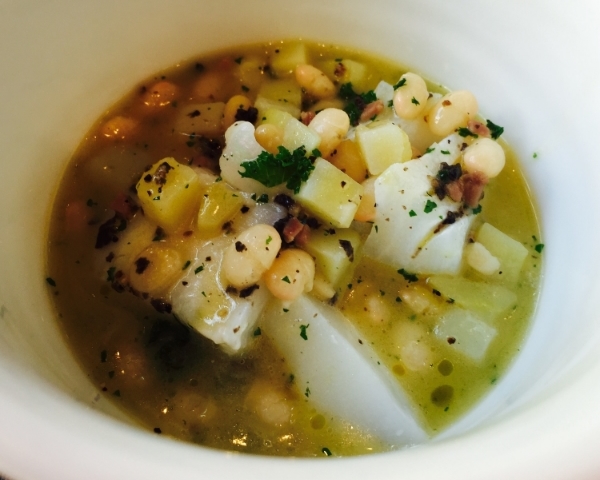My fantastic assistant, Emily Buchanan, is taking over the blog today with a guest post about her Parisian neighborhood in the l8th arrondissement. Follow her here for the latest on dependable restaurants, wine shops, bakeries, and more!
Patricia
Au Bon Coin – a neighborhood institution
Another side of Montmartre
[Guest post by Emily Buchanan]
Over the past five years or so, the outer boroughs of Paris have become hubs for gastronomic renewal. Lower rents and young restaurant-loving locals make the outer arrondissements, particularly in the north of Paris, favored locations for young chefs and restaurateurs to set up shop and make a name for themselves. Of course, not all the outer neighborhoods guarantee fine croissants, good coffee and satisfying bistro dining, but when one does spring to life and the old mingles with the new it’s always exciting to watch.
Just north of the Caulaincourt metro, away from the throngs of tourists on nostalgic Amelie tours and wandering the steep cobbled streets in search of the Sacré Coeur, is a quiet, very residential neighborhood, fast making a name for itself as a culinary hotspot of the 18th.
How do I know this? Because it’s my neighborhood. When I moved here four years ago, there was scarcely a decent bistro to speak of. Now, I can barely keep up with the new openings all over the neighborhood, from new ethical grocers, to hip, modern bistros.
If you find yourself hungry in Montmartre, skip the terraced cafés on rue des Abbesses and head north of Caulaincourt for a more authentic bite of the local Paris dining scene. Here are my favorites, old and new.
Montcalm - Modern French bistro
After only five months, this small 14-seat bistro has hit its stride, serving a simple but flavorful menu. Dishes change daily but you can expect such elegant dishes as an entrée of zucchini gaspacho adorned with thin slices of haddock, or an original take on a salmon tartare with preserved lemons, showered in salty salicorne (sea greens). Or for main course a falling-off-the bone, succulent, slow-cooked lamb from the Limousin, served with a butternut squash puree. It has a certain zeitgeist feel – modernist décor, open kitchen, bar and a menu that only gives a list of ingredients. But the food is honest, and the service genuine and friendly. An excellent addition to the neighborhood.
21 rue Montcalm | +33 1 42 58 71 35 | Open Monday to Saturday. Closed Monday dinner and all day Sunday | À la carte 30-35€.
Au Bon Coin - traditional café
A neighborhood institution, Au Bon Coin is a welcoming place to refuel at just about anytime of day: for a quick morning coffee at the bar (this is no craft coffee, just straight up French espresso with no frills), or for a more leisurely beer or glass of wine later in the day. The menu remains staunchly classic – good but not spectacular. The sautéed pommes de terre, however, are completely addictive.
49 rue des Cloÿs | +33 1 46 06 91 36 | Monday to Saturday 8am to midnight (lunch daily, dinner Monday to Thursday).
Bululu Arepera – Venezuelan café
This shoebox of a restaurant is run by a super-friendly Franco-Venezuelan couple, Joss and Victoria. The mainstay of the menu is traditional Venuezuelan areperas, baked and fried cornmeal pockets with freshly made fillings, like chicken, avocado, black beans, cheese and baked plantains. A recent favorite lunch menu entrée was a deep flavorsome beef broth with cubes of white sweet potato, and spiced up with some coriander and hot chili sauces.
20 rue de la Fontaine du But | +33 1 42 54 96 25 | Wednesday to Friday noon-11pm, Saturday-Sunday noon-5pm. Closed Monday and Tuesday | individual areperas 7€, lunch menu 14€
Owner Victoria preparing for the lunch service at Bululu Arepera
Melali Coffee Riders – Coffee bar
This new coffee bar (by the owners of Bululu, above) brews one of the best coffees you’ll find in this part of the Montmartre neighborhood, using Belleville Brulerie roasted beans. On hot days their iced coffee is hard to beat, but as the weather gets cooler it's a toss up between the guayoyo (filter coffee) or their perfectly executed cappuccino.
10 rue de la Fontaine du But| Open daily, Monday to Friday 7:30am-3pm, Saturday and Sunday 9am-5pm | coffee 2 – 4.50€
Melali Coffee Riders
Esquisse – Modern French bistro
Another new bistro addition, the bustling, convivial Esquisse (meaning 'sketch') serves up classic bistro dishes with a modern twist. I loved their hearty reinvention of a caillette (round, pâté-like pork sausage mixed with vegetables and wrapped in caul fat) using veal, a lighter, more contemporary version of its traditional Provençal counterpart.
151bis rue Marcadet | +33 1 53 41 63 04 | Open Tuesday to Saturday. Closed Sunday and Monday | À la carte 30-40€.
Le Ruisseau – Hamburger bar
At Le Ruisseau you can find a fine burger: a seriously respectable classic cheese and bacon, or go for the more unusual goat cheese burger made with Saint-Maure de Touraine, caramelized onions, honey, mustard and baby spinach. The ubiquitous hamburger joints across Paris aren’t all good, but this one is a keeper.
65 rue du Ruisseau | +33 1 42 23 31 23 | Open Monday dinner-Sunday. Closed Monday lunch | Burgers 12 – 14€ (served with home made fries or salad).
Le Ruisseau
Boulangerie Bel Ange – Bakery | Pastry Shop
The breakfast pastries in this unassuming-looking bakery are buttery yet light and perfectly flaky. And try the tasty rustic pain aux cereals, mixed grain loaf.
145 rue Marcadet | +33 1 42 58 75 74 | Open Monday, Tuesday, Thursday-Saturday 7:30am-8:30pm, Sunday 8am-8pm. Closed Wednesday.
Delmontel – Bakery | Pastry Shop
The dessert pastries in the window will have you pressing your nose up to the glass and reconsidering your latest diet. Their tourte auvergate, a dense nutty rye loaf, is worth a detour, but I give mixed reviews to their viennoiseries (breakfast pastries).
57 rue Damrémont | +33 1 42 64 59 63 | Open Tuesday to Saturday 7am-8:30pm, Sunday 7am-8pm. Closed Monday.
Il Brigante – Pizzeria
Calabrian chef/owner Salvatore Rototori was voted the best pizzaiolo (pizza thrower) in Paris by French food guide Le Fooding last year and they are not wrong. Using the freshest ingredients direct from his home region in the south of Italy, everything is good here – try the Garabaldi with buffalo mozzarella, arugula, cherry tomatoes and spicy Calabrian cured meat capicollo or La Salina white pizza with broccoli rabe (cime di rapa), buffalo ricotta and marinated anchovies and transport yourself to Italia.
14 rue du Ruisseau | +33 1 44 92 72 15 | Open Monday to Saturday. Closed Sunday | Pizza 9 – 18€
Owner Salvatore Rototori – Il Brigante
Chez Virginie – Cheese Shop
Simply one of the finest cheese shops in Paris – and one of just a handful that ages their cheese in their own cellar beneath the shop (cheese tours and cheese tastings are available in English and French). It's always a difficult decision given the vast choice of excellent cheese here, however you can't go wrong with one of their raw milk goat cheeses such as the thyme-infused baguette du thym. If you’re a cheese lover, don’t miss this gorgeously displayed and extremely well stocked shop. They also carry superior quality milk, Bordier butter, and various condiments to accompany cheese.
54 rue Damrémont | +33 1 46 06 76 54 | Open Tuesday-Saturday 9:30am-1pm, and 4pm-8pm, Sunday 10am-1pm. Closed Monday.
18 sur Vin – Wine Shop
If natural wines are your thing, or you are curious to learn more, owner Alban Le Cam knows the story behind every bottle and has an extensive selection of natural, biodynamic and organic wines, mostly from small French producers, all at modest prices. A recent summer discovery is the bold yet refreshing Côte-du-Rhone white, Vigne du Prieuré blanc 2014 from Château Gigognan, a southern Rhône white blend of Roussanne, Marsanne and Clairette.
154 rue Ordener | +33 9 81 44 10 16 | Open Monday 5-7pm, Tuesday to Thursday 10:30am-1:30pm and 4:30-9pm, Friday 4:30-9pm, Saturday 10am-9pm. Closed Sunday.
Primeur Ethique – organic grocer
I am addicted to this newly opened organic fruit and vegetable shop, mostly for its fabulous heirloom tomatoes that taste like they have been grown in the earth and sunshine, as tomatoes should. I love the fact that they have a section of produce that does not carry an organic label but has been minimally sprayed, so there’s a price point to suit all budgets.
64 bis rue du Ruisseau | + 33 7 82 59 73 40 | Open Monday 2:30-7:30pm, Tuesday to Sunday 9:30am-7:30pm. Free home delivery for online orders at
For some California sunshine in Paris, try this breezy hillside café that serves up excellent Coutume-roasted coffee, granola, breakfast muffins and healthy daily-changing lunch menus.
33 rue Lamarck | +33 1 71 37 99 95 | Open Tuesday to Friday 9am-5pm, Saturday and Sunday 10am-6pm. Closed Monday and most public holidays.
Patisserie Boris – Pastry Shop | Bakery
One of the prettiest, and most delicious pastry shops in the 18th, if not the whole of Paris. Recently reviewed here.
48 rue Caulaincourt | +33 1 46 06 96 71 | Open Tuesday-Sunday 7:45am-8:30pm, Sunday 7:45am-7pm. Closed Monday
Pâtisserie Boris Lumé
Slightly further afield from this Caulaincourt-Lamarck pocket, but still worth a mention:
La Table d’Eugene – Modern French restaurant
This has been, in my view, the best restaurant in the 18th for many years. Previously, the room was a little pokey but every dish was perfectly conceived, using the freshest of ingredients, and the prices were truly affordable. A recent interior décor makeover helped it get its first Michelin star this past March. Prices have gone up a bit, particularly in the evening but the Tuesday through Saturday lunch menu still remains very reasonable, and worth every penny.
18 rue Eugène Sue | +33 1 42 55 61 64 | Open Tuesday to Saturday. Closed Sunday and Monday | lunch menu 31 – 38€, dinner dégustation menu 79 – 99€ (120 – 160€ with wine pairings).
La Rallonge – Wine bar
Meaning ‘the extension’, La Rallonge is the wine bar annex of La Table d’Eugene. Some favorites from the Table d’Eugene menu have migrated next door to join the wine bar offerings, including the much loved ‘risotto’ de coquillettes (tiny pasta shells with cèpe mushrooms and truffles).
16 rue Eugène Sue | +33 1 42 59 43 24 | Open Monday to Saturday from 7pm. Closed Sunday | small plates 5 – 14€, cheese and charcuterie platters 8 – 33€
Les Caves du Roy – Wine Shop
You almost can’t go wrong in this wine shop, who specializes in rare wines and supplies wines for La Table d’Eugene’s extensive and well-selected list. Vintages from Eric and Joël Durand and La Domaine de la Janasse have become go-to favorites.
31 rue Simart | +33 1 42 23 99 11 | Open Monday 3-8:30pm, Tuesday to Friday 10am-1:30pm and 3-8:30pm, Saturday 10am-8:30pm. Closed Sunday and Monday morning.
For the complete reviews of some of these addresses and for other recommendations of where to eat in Paris, get The Food Lover's Guide to Paris 5th edition book or the App for the iPhone (also works on the iPad).
All photos © Emily Buchanan.






